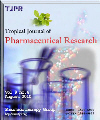
|
Tropical Journal of Pharmaceutical Research
Pharmacotherapy Group, Faculty of Pharmacy, University of Benin, Benin City, Nigeria
ISSN: 1596-5996
EISSN: 1596-5996
Vol. 13, No. 3, 2014, pp. 383-389
|
 Bioline Code: pr14056
Bioline Code: pr14056
Full paper language: English
Document type: Research Article
Document available free of charge
|
|
|
Tropical Journal of Pharmaceutical Research, Vol. 13, No. 3, 2014, pp. 383-389
| en |
Preliminary Investigation of Beagle Dog as Substitute for Humans in Bioequivalence Studies
Tiwari, Hari Krishan; Verma, Priya Ranjan Prasad; Monif, Tausif; Arora, Rachna & Reyar, Simrit
Abstract
Purpose: To assess the suitability of beagle dog as an animal model for the evaluation of formulations
in bioavailability and bioequivalence studies.
Methods: A generic cetirizine 10 mg tablet formulation was compared with another reference
formulation using beagle dog as animal model. A crossover oral comparative bioavailability study was
conducted on cetirizine tablet 10 mg in healthy, male dogs under fasting conditions. The formulations
were administered orally with the aid of water. Serial blood samples were collected from pre-dose to
48.0 h post-dose and plasma concentrations of cetirizine were determined using validated liquid
chromatography-tandem mass spectrometry (LC-MS/MS) analytical method. Pharmacokinetic
parameters were calculated using non-compartmental analysis while bioavailability was assessed using
an analysis of variance (ANOVA) model for humans and dogs.
Results: Cetirizine plasma concentrations in dog were comparatively higher, in relation to human
plasma concentrations, due to the smaller blood volume in former. There was a delay in time to reach
maximum plasma concentration (Tmax) in dog. Cetirizine formulations were found to be bioequivalent in
either of the species (dog and human). The ratio (test\reference) of least-squares mean for area under
plasma concentration curve from time zero to last detectable concentration (AUC0-t), area under plasma
concentration curve extrapolated to infinity (AUC0-∞ ) and maximum plasma concentration (Cmax),
calculated for the dogs were comparable to those for humans. AUC0-t, AUC0-∞ and Cmax ratios ranged
within 92.81 - 106.80 % for dogs and 95.43 – 104.84 % for humans
Conclusion: The results suggest that beagle dogs can be used in place of humans in bioequivalence
tests on generic products of cetirizine.
Keywords
Cetirizine; Beagle dog; Bioavailability; Bioequivalence; Pharmacokinetics; Non-compartmental
|
| |
© Copyright 2014 - Tropical Journal of Pharmaceutical Research
Alternative site location: http://www.tjpr.org
|
|
